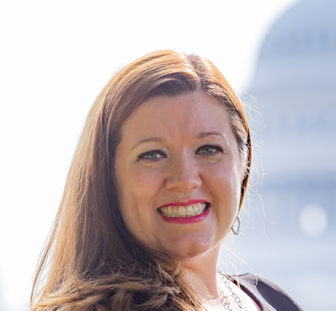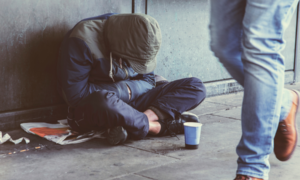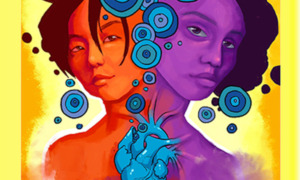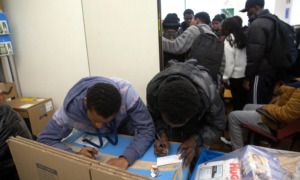
Suzanne Tucker/Shutterstock
.
Resilient, talented and unique describes the 4.2 million youth and young adults who experience homelessness in our country every year. Their faces, reality and experiences are too often ignored and invisible to mainstream society, culture and politics.
Young people’s experiences of homelessness are fluid, taking shape in different forms. A young person is staying temporarily with friends or acquaintances, never knowing how long they will be welcome — this is what homelessness looks like. When a young person has found refuge on the streets because the trauma of being confined with their abuser left them without any other choice but to escape, this is what homelessness looks.

Darla Bardine
When a young person seeks the kindness of a caring adult in a shelter, this is what homelessness looks like. When a college student is sleeping in the backseat of their car waiting for classes to begin the next morning with the dream that they can finally break free of the intergenerational history of trauma, poverty and homelessness that he experienced every day as a child when he and his mother lived in and out of shelters.
Ninety-one percent of polled Americans believe that dealing with the issue of youth homelessness is important. Eighty-eight percent agree that the success of young Americans has a direct impact on the success of their communities. While most polled participants agreed that youth homelessness should be addressed, many did not understand the full size and scope of the issue.
Youth and young adults experiencing homeless too often remain anonymous. Why? They remain anonymous because of the stigma of what it means to be homeless and because the primary homelessness system does not acknowledge all forms of homelessness that they experience to be “homelessness.” As one young person described, “When we lived with other people, they were not always nice to us. We couldn’t ask them for anything. They were mostly mad that we were there and did not want anyone else to know. …”
Root Causes
Youth homelessness is not a choice. It stems from multiple forms of injustice and is deeply rooted in structural racism, discrimination, systemic oppression and intergenerational cycles of poverty, addiction and trauma. Research shows that youth homelessness disproportionately impacts youth of color and LGBTQ youth. In addition, the lack of a high school degree or its equivalent, and being unmarried while pregnant and parenting significantly increases the likelihood that a young person will experience homelessness.
Youth and young adults involved in multiple systems, including the foster care and juvenile justice systems, was also linked to a higher likelihood of experiencing homelessness. Reports have shown that youth experiencing homelessness often face discrimination in the forms of racial or ethnic identity, gender identity and the situation of homelessness itself. For example, a study on 12- to 20-year-old youth and young adults experiencing homelessness in Los Angeles County found that lesbian, gay and bisexual youth reported more discrimination than heterosexual youth experiencing homelessness, including discrimination from peers, family and the police. Further, a study of youth experiencing homelessness (14 to 23 years old) in New York City found that they reported experiencing discrimination associated with their age, sexual orientation, gender identity, educational achievement, homelessness and race/ethnicity.
And it goes beyond the coasts as the rate of homelessness among youth and young adults was found to be as common in rural communities as it is in nonrural communities. Rural communities, defined by the U.S. Census Bureau as counties with more than half its population living outside urban areas, are also witnessing instances of youth and young adults experiencing homelessness. In addition, disconnection from education and employment are higher in rural communities than in urban counties.
The path to justice must include changing homelessness assistance policies from the U.S. Department of Housing and Urban Development so that all forms of homelessness that youth and young adults experience are defined as homelessness and is eligible for services and housing. Justice is ensuring access to youth-centric services so that youth are not put in vulnerable situations that lead to abuse, assault, sex and/or labor trafficking and exploitation. Justice looks like systems working collaboratively to ensure that no youth exits to homelessness of any form. Justice looks like increasing targeted investments to youth and young adult homelessness programs so that they don’t become chronically homeless adults in the future.
Solutions
How can we as communities of professionals, parents, students and peers inform and educate others on youth homelessness — its root causes, the fluidity and forms of homelessness itself, and what we lose in both financial and human costs, both locally and nationally? We can do this by encouraging others to talk about the prevalence of youth and young adult homelessness with our legislators and ask them to support changing laws to define homelessness based on the actual lived experiences of youth and young adults themselves and by ensuring that federal and state funding streams for programs that provide housing and wraparound services for youth and young adults are significantly expanded.
The federal government currently spends approximately $30 per young person who experiences homelessness, per year. The expectation that $30 a year can change the trajectory of someone’s life — someone whose needs to heal from trauma and access emotional support, structure, safe housing and consistency — is impractical. More needs to be done. Our young people deserve better. They deserve the opportunity to hope for and realize a future and to live a life beyond homelessness where they can thrive as valued members of society.
Homelessness is not a choice. Every youth and young adult should have multiple opportunities to sleep somewhere other than on someone else’s couch, in a car or on the streets. The Runaway and Homeless Youth Act (RHYA) has continued to provide the security, stability and support that youth, young adults and young families need through service-rich and quality programs, and invested staff. Because of RHYA’s funding to local organizations and agencies, many youth and young adults have a safe place to sleep at night, a meal to eat and caring, supportive adults in their life. But the federal funding amount of only $127 million per year is not enough to meet the need.
Everyone has a role to play to help solve youth and young adult homelessness in America. Please:
- Encourage your members of Congress to support a full programmatic reauthorization of RHYA and
- Urge your members of Congress to increase funding for the Runaway and Homeless Youth Act.
- Ask your U.S. representative to co-sponsor the Homeless Children and Youth Act so that all forms of homelessness experienced by youth and young adults are eligible for housing assistance.
There are 4.2 million youth and young adults among us who are counting on us.
Darla Bardine is a public interest attorney serving as executive director of the National Network for Youth.































